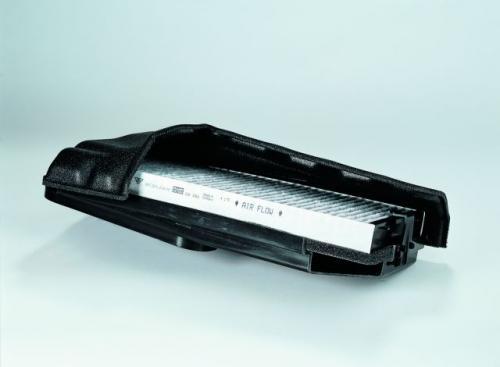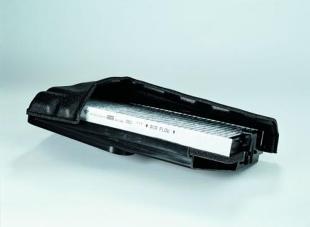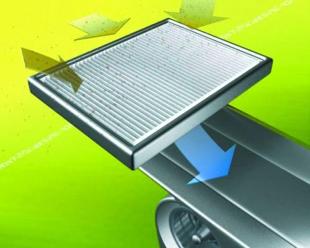
Cabin comfort
 Car filters are not the protagonists of the technological story, but without them, the car show would have ended in complete failure.
Car filters are not the protagonists of the technological story, but without them, the car show would have ended in complete failure.
More and more cars are equipped with cabin filters. No wonder, because every third driver is allergic. Cabin filters prevent the penetration of pollen from flowers, trees and grass into the car interior, the formation of unpleasant odors, and help maintain good visibility. The quality of the cabin filter is confirmed by the efficiency w  capturing pollutants. It is especially important to separate the smallest impurities that can go straight into the lungs, bypassing our natural filtering system, which are ... fine hairs in the nose. High quality filters trap particles smaller than 1 micrometer (1 micrometer = 1/1000 of a millimeter). Harmful gases and unpleasant odors should also not enter the car interior.
capturing pollutants. It is especially important to separate the smallest impurities that can go straight into the lungs, bypassing our natural filtering system, which are ... fine hairs in the nose. High quality filters trap particles smaller than 1 micrometer (1 micrometer = 1/1000 of a millimeter). Harmful gases and unpleasant odors should also not enter the car interior.
In the dust tunnel
Air entering a car contains soot, dust, pollen and exhaust fumes. In addition to conventional pollen filters, activated carbon filters are increasingly being used, which trap not only dust, but also gases.
This deadly mixture is contained in the clouds of exhaust gases coming out of the exhaust pipes of cars. Together with the exhaust gases, we inhale the pollen that causes hay fever,  allergies and even asthma. An open window will not help, because all the impurities are sucked in with the fresh air supply. As a result, the concentration of exhaust gases and soot inside the car is much higher than in the air outside the car.
allergies and even asthma. An open window will not help, because all the impurities are sucked in with the fresh air supply. As a result, the concentration of exhaust gases and soot inside the car is much higher than in the air outside the car.
Non-woven fabric and activated carbon
A few years ago, the so-called combined car filters were only intended for middle class or luxury cars. These filters are now available for almost all new cars. Combined filters consist of a pollen filter with an adsorption layer that traps gases. Adsorption is possible due to the use of activated carbon, which traps some harmful gases.
The group of cabin filters includes pollen filters, etc. combined filters with a layer of activated carbon. Pollen filters are made of a special non-woven material that absorbs dust, soot and pollen almost one hundred percent. On the other hand, Adsotop activated carbon filters absorb up to 95 percent. harmful gases, including ozone and carbon monoxide.
The main raw material for the production of activated carbon is finely ground and carbonized coconut shells. The action of the filter is based on the fact that carbon adsorbs gas molecules and  keeps them on the surface of the pores. The effectiveness of activated carbon depends on the pore structure and the size of the inner surface of the filter. One filter can contain from 100 to 300 grams of activated carbon. For example, activated carbon in the MANN cabin filter with index CUK 2866 for Volkswagen Golf has an area equal to the area of 23 football fields (approx. 150 thousand m2 ).
keeps them on the surface of the pores. The effectiveness of activated carbon depends on the pore structure and the size of the inner surface of the filter. One filter can contain from 100 to 300 grams of activated carbon. For example, activated carbon in the MANN cabin filter with index CUK 2866 for Volkswagen Golf has an area equal to the area of 23 football fields (approx. 150 thousand m2 ).
In the US, almost 30%. Vehicles are equipped with cabin filters. In Europe, almost every new car already has a cabin filter, and about 30 percent have activated carbon filters. In Germany, more than 50 percent. new passenger cars are equipped with activated carbon cabin filters.
Filtration quality
Qualitative differences between filters arise at the production stage. The most important role is played by the filter medium inside the filter housing and in the air supply. It may be a multilayer nonwoven fabric. The first layer separates larger dust particles larger than 5 micrometers, the second layer with smaller pores separates particles larger than 1 micrometer. Combined filters have an additional third stabilizing layer and are used as a carrier for activated carbon.
Activated carbon grains between the second and third layers protect and provide optimal adsorption.
Less pressure loss
Unlike engine air filtration, where the engine draws in air at a higher negative pressure, cabin filters have a very large intake air volume compared to a relatively weak fan motor. The degree of separation, the surface of impurities in the material and the pressure loss (pressure difference between the side from which impurities settle on the filter and the clean side of the filter) are in a strictly defined relationship. Changing one parameter has a decisive influence on other parameters.

